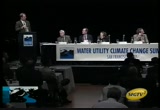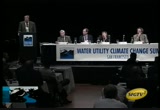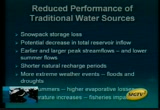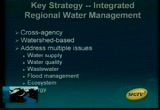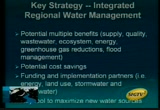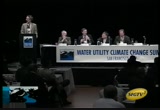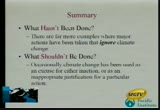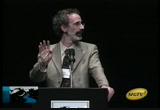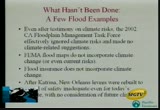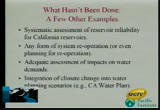tv [untitled] September 15, 2010 4:00am-4:30am PST
5:00 am
third is how we think manager's have a roll to play especially in the american west. there are three response strategies i'd like to talk about. scenarios and strategies is our topic on this panel. the first strategy we think is key, is looking - not just about the impacts of our climate change on our existing cl climate change but looking how it effects the tools into the future. looking forward and how it will effect the tools available to us in the future. the next strategy is integrated water ma'am meant and third one, is inbe greating energy in water issues. let's start just for a moment and talk about what we know are likely impacts of climate change and what that means on how water manager's tools will perform. a number of folks mentioned
5:01 am
that they would see more evaporation, that means keeping this patch of green on green will take more than it did today. that means investment today in conservation and agriculture conservation. things that effect directly or indirectly evaporation transfers will save more tomorrow. they will perform bet er the future than today. there are a number of tools like that. we know we're doing to see more extreme weather events and higher and extreme lows. some of this is already happening. that means urban areas will necessarily be investing in flood management and watershed management. those are essential parts of the flood management and some
5:02 am
water utilities have flood water management and some don't. that suggests there's a real opportunity for water managers to work together with flood management to receive double management and benefits. a lot of these flood management benefits have strategies rather, have the potential to supply benefits. we think they will perform greater in the future. the third time you've seen this slide. we know we'll ceo level rise. that means example, in the next slide, shows especially in coast areas. next. that means there is about lot of good news with regard to climate change if your a water
5:03 am
manager. but a little good news is these are tools that we think will perform better in the future from a water manager's perspective. the next slide show s tools that will not be reduced in performance by climate change. waist management, local shower heads, ground water clean up. those are important tools that are relatively climate insensitive and will be an important part of the water management portfolio going forward. it's important to note, and there has not been a lot of discussion about this. the range of tools performing on high drolg, if you invest in this you should expect it will perform more poorly in the
5:04 am
future than today. that's not just a matter of looking that vulnerability of your existing system but it helps drive water manager's choices going forward. because - if you look at the next slide, the question of water manager's impact starts with snow,pack, storage loss, but if your planning a reservoir it's important to note there's a significant potential for decrease in total reservoir inflow. a number of panelist mentioned that so if your thinking to invest, make sure the water your thinking about capturing will be there in several decades. if your thinking about a new or augmented storage, surface diversion. think about what's going to happen to stream flows and if the water is there in several
5:05 am
decades. it may be there today and not in the future. you think of relying on new ground water basins that rely on natural recharge. think about higher evaporation losses. what these things have in common is that tools that rely on traditional, natural ,hydrology, will work better in the future. there's one exception. our existing system because of snow,packs is likely to spill more water tomorrow than today. those uncaptures spills is water that can be captured by new storm. what we have not seen and we looked around the west, we have not seen anything look at all
5:06 am
those of 6 or 7 previous factors that reduce yield and increase yield in that issue. we think balance on all those tools will perform more poorly, that does not mean they're off the table but as water supply options they're going to get more expensive in the future than today. next. what about desalinization, the source is less effected by climate change than fresh water. it presents design issues but water manager cans plan around that. the key issue is, energy. desalination is energy intensive and those will be increasingly scrutinizeed the
5:07 am
future because of climate issues. it's about one third in southern california next most sensitive operation but that gap is shrinking rapidly and it's conceivable in a decade or sooner, it might take less to de sal has been declining and we may actually at some point reach a breaking point that a lot of folks did not think was possible and we might be able to invest in desalination, it's really interesting potential development. next slide. what that means, is when you look at how it will effect the full range of water management tools available of tools that
5:08 am
rely on snow,pack, traditional resources will perform more poorly with de sal as the wild card there. the good news here - and i brought that the sources we believe are the sources with the greatest potential in the future. this shows the potential yield from a range of water sources and the interesting news here that the big column on the right is conjunctive and the next one is waist water recycling. the tools we think are more effective or unchanged as a result of climate change actually are the tools with the
5:09 am
greatest potential each before climate change is considered. we think that's really good news. so, how do you take advantage of the new sources? the next tool, i just finished my first strategy and this is integrated water management. we think the new tools conjunctive management, integrated water management is going to be particular important. by that, we mean cross agencies not just water utilities but looking at all the agencies locally. waist management agencies flood management and energy agencies. a full sweep across medium activities that are watershed based that address a full range of supply quality, waist water,
5:10 am
et cetera. the advantage to this is first, potential multiple benefits. the example that we will include in our document the shed where integrated has shown remarkable potential to come up with really innovative tools that were almost unthought of a decade past. cost savings and can bring funding and partners to the table. we think it will be and important tool for maximizeg the new tools. if your a water agency trying to improve landscape conservation and the local land use agency or jurisdiction of city and county is tremendously important. if your trying to emphasize
5:11 am
stone water recapture,, so it's key to maximize the agencies. the third strategy is integrated management into this report all called energy down the drain and hit was releaseed 2004, that looks at energy implications of water management decisions. the results we found were striking and then the state of california and the numbers they came up were very interesting. they want a project alone represented 7 to 3 thousand of the water consumption alone. the california electricity about 19 percent of that is driven by water management and 30 percent of the natural gas is consumed by water.
5:12 am
these are really big numbers that i think, for a water manager offer an interesting opportunity. that means water management investments have apart to be part of a greenhouse gas solution and the sources that can attract new funding streams in order to save the energy. we did sort of a sensitivity analysis, looking at potential savings of those. and we worked with an agency to share real numbers with us and we found the difference between the least and most energy intensive options in san diego, we looked that difference in conservation and importing new water supplies from the state water project. the energy difference is about enough to power a quarter of the
5:13 am
households in san diego. we think those are issues that are going to be important for water managers to pay attention to and opportunities we think provide funding opportunities for water managers. those are the tools. looking at climate impact on water tools and integrated water management and integrated issues into water management. we think you should integrate these into your ma management moving forward. a lot of information, all water presentations have to end with this slide pretty much. - which is the promise of the snow,pack, that water is up there waiting to meet your needs in the warm months. it's a less comfort than it used to be.
5:14 am
we'd like to suggest another image a little less glamorous but it saves energy and water and can be a solution and more importantly, it's something water manager's have some control over. a little less glamorous but that's something together we can work on. thanks a lot. [applause] >> well good afternoon everybody. you've been very patient and i realize i'm the last thing to be inflicted upon you with my power point. i have to reiterate barries comments. there's been a great group of people and topics and probably the only better conference i've been to was in nebraska. a long time back, they are way ahead of you on this.
5:15 am
i was delighted to hear lester snows understanding of global climate change and we'll have to start calling him lester rain however, and your probably really sick of hearing that, so, next slide. what i'm going to do is talk a little bit about - not the science or impact which i've worked with quite a bit - but rather resources for managers to try and close some of the discussions. you heard this and this is a conclusion from years back from the water assessment approach. the people are chaning. and it's effecting society and water sources are now
5:16 am
unavoidable. again 7 years back, and by no means i went back to my records and congress don edwards some of you may remember, held a hearing in 1987 on impacts of climate change on san francisco bay area and that was years back but it's getting a lot of attention but not a new issue. this graph could be temperature over time or green house gas over time. population. but what it is, actually is the number of publications scientific publication addressing climate change and water resources globally from 1950 up until the present and mike is still here. he was the lead author on this article it came out in the
5:17 am
journal of climate change, i think, last year that looked that range of literature out there and the issues addressed and regions and topics and so on. we actually have on-line that institute this bibliography and you can do searchs by author, subject, reen on, whatever. there's the url. i stuck in the word reservoir and it turns out there's 60 some odd articles on this. so this is not new scientific subject. i'll talk about four things. what should be done. there have been proposals for decades of what water managers should do both generally and specifically. i'm going to talk about what has been done and argue that
5:18 am
actually, very little has been done. there has been a handful where things have been taken to improve our situation, but not many. i'm going to talk a little about what has not been done. there again there are far more examples we've done major things in water area but ignored climate change. and what shouldn't be done. there are things we should not do given our understanding of climate change and water resources. i can argue recently climate change is argued as a reason to justify something, either justifying not doing something or taking an action that we probably ought not to do and i'll give you some examples of that. so, what should be done? again i'll skip over some of this
5:19 am
because you've heard it. this is the report of theiuc, the next one is coming out friday. impacts is coming out a little after that. it was explicit in the water area and said water manager's should begin a systematic contingency plans and water allocation policys in the context of climate change. interestingly, ten years back, the,awaa, published a climate panel that said while water management systems are often flexible water manager's should examine under a wider range of
5:20 am
traditional use. they said it's not uh. they made that recommendation and not that much actually has been done ultimately. many other suggestions of what should be done you've heard a lot of them already. i do want to show this slide. this is mississippi river, the actual flow at saint louis. the data comes from the armed corporation to around the year 2000, to 2001. if you draw a straight line here, the straight red line is basically the flood risk, assume this record is stationary that the climate is not changing. in fact, statistically, if you ⌜"at this record, it's not
5:21 am
stationary. average flow in the mississippi river seems to be going on. i don't know if it's climate change but its the kind of thing that makes long-term planning managers nervous. one is the model you plan for the average flood over the last historical record or potentially the tree ring record or whether you assume climate is not stationary and in which case, the model of what you do and the assumptions, and the conclusions of what you do will all be different. so what has been done? well, i don't think a whole lot. a lot of the thinking and a lot of things have been done in modeling and planning but in terms of on ground action, not much is done. i know city of san francisco is
5:22 am
re-evaluating storm water systems redesigning and potentially rebuilding and their beginning to look at sea level rise and what it means for inflow and out flow structures and greater precipitation events and what that means for design. where that leads to physical design or not, remains to be seen but its the right step to be taken. there are other things done beyond the studies. some might be useful. i talked to joel about this. it would be great to have a collection of real on ground so you can deal with the explicit issue of climate change whether or not reservoir rules have been adjusted already. what's actually been done? what changes have we seen?
5:23 am
success stories would be very valuable to a lot of management in different places what has not been done? unfortunately, my list is longer here. a few flood examples in 2002 the california flood management task force held a hearing and a number of speakers came and talked about climate change and change of the way we do flood changing and maybe i'm miss reading the flood change task force but i would argue they ignore that and nothing they recommend took climate change into account. we no, fema, flood map's don't incorporate future risks and some say they don't adequately incorporate flood risks. the story we heard from david
5:24 am
on often does but insurance companies are interested in this because they obviously have a financial stake in that and we may see some changes in insurance policies. after katrina, the new orleans levies were built to the exact same standards before. i didn't want to argue about the height but they certainly did not include climate change and one would argue they built them at an ineffective manner to begin with but they did not rebuild with climate change. brad said the colorado river and it's use of,hydrology, and it occurred to me, why are they
5:25 am
not addressing climate change. why is the bureau not integrating it into the analysis of the system and i'll come back to an example of that in a moment. we have not yet done in california a systematic assessment of reservoirs. there have been some studies on specific reservoirs or river basins and how flexible or inflexible they might be under existing rules and there are a couple of studies that look at different kinds of reservoir rules but not systematically and i don't think there's been any system reoperation. corner me later and tell me i'm wrong but i would argue that on the demand for water.
5:26 am
it has been mentioned a couple of times here. seattle may have done that and port land may have integrated it into management. temperature is going up, demand for water is going up. how many of our water agencies include in their demand forecast for the year 3020, 3050, climate effects on demand. the last california water plant did a much better job of acknowledging the issue of climate change but not yet adequately took action. we're beginning to work now on the next one and the intention i believe, is there will be a more deeper analysis and i look forward to that. next slide. this is a graph, and i want to
5:27 am
say couple of things. this is from a study that a coleague of mine did on impacts of changes on colorado river. we looked at climate general circulation models from hypo thetic there's a lot of information and this is a small piece of that. this shows frequency and volume of uncontrolled spills which is basically meaning floods. these are percent changes of flow on,x factors. 10, five, ten, twenty percent changes on flows. those are plausible in colorado. the,y axis is number of years in which we get plugs out of
5:28 am
records. 78 years. there are two things to catch from this. one, is first of all, the vulnerability of the relative moderate increase of flow in the colorado. a ten percent increase in flow. changes the number of years with uncontrolled spills, floods, from six out of 78 in the data case to 16 out of 78 years some more than doubles the ten percent increase, more than doubles the years you have uncontrolled spills and different colors, blue is little spills and most are red the big ones. sorry the smaller one. you don't get really big spills undercurrent conditions. but when a 20 percent increase
5:29 am
in flow your getting more inflows. the system is sincetive to climate. the second important point here is, this whole project. assessing the risk, assuming we operate the system the same way thomas we operating today, we were told when we proposed the project we could not change the operating rules that reservoirs and could not change water rights and change the rule of the law of the river, basically. we had to do assessment of the water vulnerability in current conditions. that's a key point. how vulnerable are we - not under existing conditions although this is important information to know - but how vulnerable would be be
69 Views
IN COLLECTIONS
SFGTV2: San Francisco Government Television Television Archive
Television Archive  Television Archive News Search Service
Television Archive News Search Service 
Uploaded by TV Archive on

 Live Music Archive
Live Music Archive Librivox Free Audio
Librivox Free Audio Metropolitan Museum
Metropolitan Museum Cleveland Museum of Art
Cleveland Museum of Art Internet Arcade
Internet Arcade Console Living Room
Console Living Room Books to Borrow
Books to Borrow Open Library
Open Library TV News
TV News Understanding 9/11
Understanding 9/11